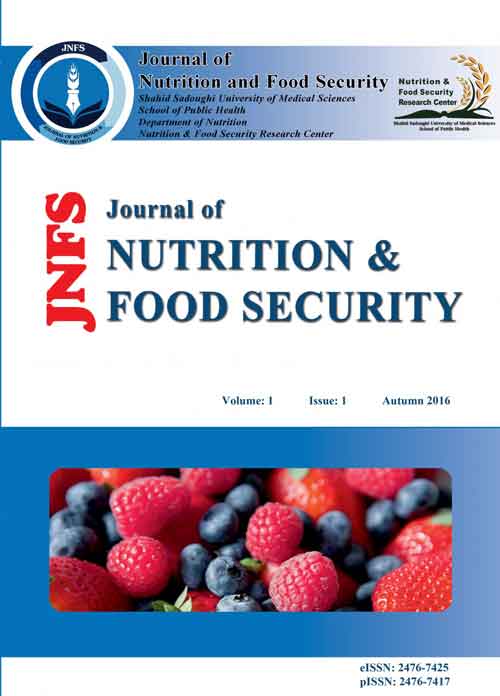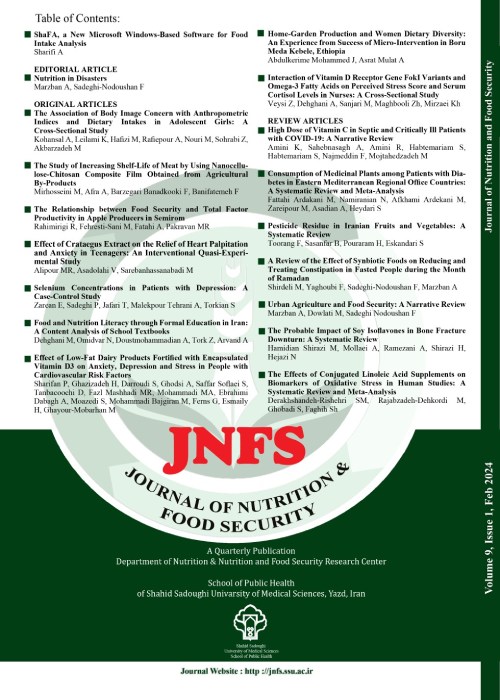فهرست مطالب

Journal of Nutrition and Food Security
Volume:1 Issue: 1, Dec 2016
- تاریخ انتشار: 1395/07/25
- تعداد عناوین: 9
-
Editor's welcomePage 0
-
Pages 1-8BackgroundConsumption of dark chocolate has been often hypothesized to have a role in the prevention of chronic diseases. The objective of this study was to investigate the effects of consumption of dark chocolate (DC) on serum oxidative stress and blood pressure in patients with metabolic syndrome (MetS).MethodsAn 8-week parallel randomized clinical trial involving 114 patients with MetS was conducted on stable medication in 2014. Participants were randomly assigned to three groups: 1) consume 40 g/d DC (40G), 2) consume 20 g/d DC (20G), and 3) consume no DC as the control group (CG). Blood pressure (BP), radical scavenging activity of 1-diphenyl-2-picrylhydrazyl (DPPH), and Malondialdehyde ( MDA ) were measured at baseline and after 8 weeks of intervention.ResultsMean age, weight, and body mass index ( BMI ) of participants were 51.38±6.95 years, 77.34±12.86 kg, and 28.65±4.4 kg/m2, respectively. No significant differences were found among the three groups in relation to these variables after the intervention. The mean change of SBP in 40G, 20G, and CG were 0.31±1.81, 0.37±1.65, and 0.26±1.56 mmHg (p=0.3), respectively. These figures for DPB were obtained as 0.08±1.03, -0.02±1.12, and 0.22±1.03 mmHg. No significant changes were observed in MDA and DPPH between three groups.ConclusionEven daily intake of 40 g of dark chocolate with 76% purity for an 8-week period had no effect on body weight, BMI , BP, and oxidative stress in patients with MetS.Keywords: Cocoa, Dark chocolate, Metabolic syndrome, Oxidative stress biomarkers
-
Pages 9-15BackgroundMetabolically obese normal-weight (MONW) children and adolescents are characterized by body mass index (BMI) lower than 픠 with metabolic disorders such as hyperglycemia, hypertriglyceridemia, and/or hypertension. This study wants to determine prevalence of MONW, metabolically benign normal weight (MBNW), metabolically abnormality obese (MAO) and compare the components of metabolic syndrome (MetS) in some Iranian normal-weight children and adolescents in Ahvaz, Iran.MethodsThis cross-sectional study was conducted on 1124 boys and 1128 girls, aged 1018 y, Ahvaz, Khuzestan. Participants were selected from 6 health centers in Ahvaz by a multistage cluster random sampling method. The Mets was defined according to the modified Adult Treatment Panel III (ATP III). Anthropometric measurements and blood pressure were measured according to standard protocols. Fasting blood samples were collected for biochemical assessment.ResultsMetS prevalence in normal weight group was 5.4% and 1.45% in boys and girls, respectively (p = 0.001) showing a significant difference. Triglyceride abnormality percentages (MBNW = 23.9%, MAO = 88.8%, MONW = 91%) and high density lipoprotein (MBNW = 19.2%, MAO = 73.8% and MONW = 67.2%) were higher than other MetS components in these groups.ConclusionsSince BMI in children and adolescents with metabolically obese-normal weight is normal the continuous measurements and treatment of MetS components especially in boys are important from public health view. The components mean of MetS was higher in MONW and MAO individuals compared with MBNW.Keywords: Metabolic syndrome, Metabolically obese, normal weight, Children
-
Pages 17-27IntroductionThe prevalence of hypertension in patients with type 2 diabetes (T2D) is approximately twice as much as healthy people. This study was designed to determine the effect of L-arginine supplementation on blood pressure in patients with T2D.MethodsIn a double-blind randomized clinical trial, 75 T2D were randomly divided into three groups (3 g/d and 6 g/d of L-arginine and placebo) for 3 months. Height, weight, waist circumference, dietary intake, and blood pressure (BP) were measured before and after intervention.ResultsIn patients who received 3 g/d L-arginine, no significant difference was observed between BP before and after the intervention, however, subgroup analysis among patients with high BP showed significant reduction in systolic (p = 0.036) and diastolic BP (p = 0.027) after L-arginine supplementation. After 3 months of intervention, systolic and diastolic BP were significantly different compared to the baseline values and also with placebo value in patients receiving 6g/d of L-arginine (pConclusionThe daily intake of 6 g of L-arginine for 3 months in T2D may improve BP. Taking 3 g/d of this supplement may help to improve BP only in patients with hypertension.Keywords: L, arginine, Diabetes, Blood pressure, Clinical trial
-
Pages 29-39BackgroundThe present study was conducted to investigate the possible effects of L-carnitine and glutamine and their synergistic effects on male soccer athletes.Methods28 male soccer players (21.1±0.7 y) were enrolled in a randomized pre and post intervention, double-blind design. Before the intervention, their performances were assessed by Bruce protocol, and their body composition was measured with the Body Composition Analyzer. Then, athletes were randomly allocated into four groups: 2 g L-glutamine, 2 g L-carnitine, 2 g L-carnitine 2 g L-glutamine and placebo. Supplements were prescribed for 21 days and after three weeks, athlete's performances and body composition were re-evaluated.ResultsThe results showed that body weight, body fat percentage, lean muscle mass, and dietary intake made no significant changes in different groups of athletes. In between groups comparison, results did not significantly change in any performance indices. However, in L-carnitine supplement group, the results of pre and post intervention showed that the running distance and maximal oxygen uptake (VO2max) increased significantly while the subjective sense of fatigue decreased significantly.ConclusionBased on our findings, a three-week prescription of separate or combined glutamine and L-carnitine, had no effects on body composition or dietary intake in soccer players. But, the athlete's energy intake was more than the one reported in other studies. Although further studies are required to assess these effects on athletic performance.Keywords: L, carnitine, L, glutamine, Body composition, Dietary intake, Soccer, Performance
-
Pages 41-48BackgroundThe current study tried to investigate the antioxidant and anti-bacterial effects of green tea and grape seed extract (with a volume of 2%) on durability of Tilapia packed in polyethylene bags, which were kept in cool temperature of 4±1 °C.MethodsPrepared fish were divided into 3 batches: 2 batches were treated by dipping for 30 min in ethanolic of green tea extract (2% v/v) and grape seed (2% v/v), respectively, while the third batch was dipped in distilled water as a control sample. The control and treated fish samples were analyzed for microbiological such as total volatile count and psychrotrophic count, and chemical such as thiobarbituric acid (TBA), and free fatty acid (FFA) values. The sensory characteristic was over a period of 20 days.ResultsThe results indicated that the two extract's treatments delayed significantly (pConclusionthe present study showed that the grape seed extract and green tea were very effective in extending the shelf life of Tilapia during refrigerated storage.Keywords: Tilapia, Grape seed, Green tea
-
Pages 49-62BackgroundThe prevalence of metabolic syndrome (MetS) is increasing worldwide. Limited data are available trying to compare different definitions suggested to identify MetS. This study aimed to compare the prevalence of MetS and its components based on currently available international and Iranian national definitions.MethodsThe present cross-sectional study was conducted in 2015 among female teachers residing in Yazd city. Demographic data and information on physical activity, participants education, economic status and number of deliveries were gathered using self-administered questionnaires. Anthropometric measurements and serum lipid profile were assessed according to standard procedures. MetS was defined based on international diabetes federation (IDF), national cholesterol education program; adult treatment panel III (NCEP, ATPIII), and Iranian national definition.ResultsA total number of 450 participants aged 40.60±8.25 years were included in this analysis. Prevalence of MetS based on ATPIII definition, IDF definition, and Iranian modified definition were 39.11%, 40.89%, and 31.11%, respectively. Prevalence of MetS among women aged over 50 years was more than those aged 20-50 years (PConclusionsThe prevalence of MetS was high in female teachers living in Central province of Iran. It seems that ATPIII and Iranian national criteria can better represent the differences in the prevalence of MetS. Large scale prospective studies are recommended to confirm our results.Keywords: Prevalence, Metabolic syndrome definitions, Female teachers, Iran
-
Pages 63-71BackgroundAccording to the high prevalence of cardiovascular diseases (CVD) in developing countries as well as high treatment expenses for patients and health-care systems, CVD prevention in such societies has a great importance. One of the most effective strategies is improvement of knowledge and attitude towards the CVD risk factors. This study aimed to evaluate the knowledge and attitude of females on CVD risk factors and also the relationship between knowledge and attitude with obesity indices and biochemical parameters.MethodsThis cross-sectional study was performed on 89 women with the age range of 11 to 67 years old and BMI of 24 to 51 kg/m2. Participants were interviewed face to face using a valid questionnaire in order to evaluate their knowledge and attitude on CVD risk factors. Blood sampling was implemented after 12 h of overnight fasting. Fasting blood sugar and lipid profile were assessed by enzymatic methods. Anthropometric measurements were performed and obesity indices were calculated.ResultsMore than 70% of participants had moderate or good knowledge and attitude about CVD risk factors. Participant's knowledge and attitude had a significant positive association with educational level and a significant reverse relationship with age, total cholesterol, LDL-cholesterol, and obesity indices.ConclusionResults of this study indicated that knowledge and attitude levels on CVD risk factors affect the obesity indices and metabolic profile. Hence, knowledge and attitude enhancement is the main target and initial step in improving life quality and preventing cardiovascular diseases.Keywords: Cardiovascular Diseases, BMI, Knowledge, Attitude
-
Pages 73-79BackgroundIn recent decades, studies on type 2 diabetes (T2D), have adopted a new approach to the field of a more complete collection of variables related to the lifestyles and diet of people. Diet is an important factor in increasing the rate of T2D among individuals. Considering the consumption of a high-carbohydrate diet, little attention has been paid to the type of carbohydrates consumed in the incidence of T2D. The present study aimed to review the literature on the relationship between the glycemic index (GI), the glycemic load, (GL) and T2D, it also targets at evaluating and comparing the results of similar studies in other countries.MethodsUsing search engines, including PubMed, Science Direct, Embase and Scopus, and key words such as GI, GL, diabetes; articles with cross-sectional, clinical trial, Prospective and retrospective cohort designs between 2000 to 2016 were selected. Moreover, non-English language articles were not investigate.ResultsThe results of these studies showed that a diet containing low GI and GL has beneficial effects on the metabolism of glucose in the body and is also considered as a factor to protect the body against T2D and its complications. Monitoring eating habits of people with T2D can have beneficial effects on T2D and its associated risk factors.Keywords: Diabetes, Glycemic load, Carbohydrat, Glycemic index


